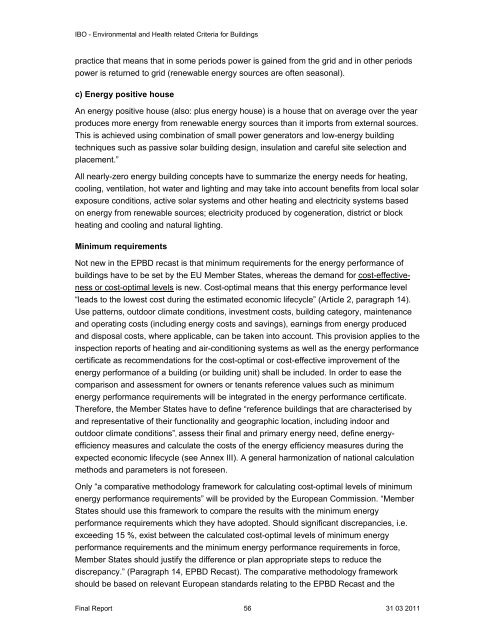Environmental and health related criteria for buildings - ANEC
Environmental and health related criteria for buildings - ANEC
Environmental and health related criteria for buildings - ANEC
Create successful ePaper yourself
Turn your PDF publications into a flip-book with our unique Google optimized e-Paper software.
IBO - <strong>Environmental</strong> <strong>and</strong> Health <strong>related</strong> Criteria <strong>for</strong> Buildings<br />
practice that means that in some periods power is gained from the grid <strong>and</strong> in other periods<br />
power is returned to grid (renewable energy sources are often seasonal).<br />
c) Energy positive house<br />
An energy positive house (also: plus energy house) is a house that on average over the year<br />
produces more energy from renewable energy sources than it imports from external sources.<br />
This is achieved using combination of small power generators <strong>and</strong> low-energy building<br />
techniques such as passive solar building design, insulation <strong>and</strong> careful site selection <strong>and</strong><br />
placement.”<br />
All nearly-zero energy building concepts have to summarize the energy needs <strong>for</strong> heating,<br />
cooling, ventilation, hot water <strong>and</strong> lighting <strong>and</strong> may take into account benefits from local solar<br />
exposure conditions, active solar systems <strong>and</strong> other heating <strong>and</strong> electricity systems based<br />
on energy from renewable sources; electricity produced by cogeneration, district or block<br />
heating <strong>and</strong> cooling <strong>and</strong> natural lighting.<br />
Minimum requirements<br />
Not new in the EPBD recast is that minimum requirements <strong>for</strong> the energy per<strong>for</strong>mance of<br />
<strong>buildings</strong> have to be set by the EU Member States, whereas the dem<strong>and</strong> <strong>for</strong> cost-effectiveness<br />
or cost-optimal levels is new. Cost-optimal means that this energy per<strong>for</strong>mance level<br />
“leads to the lowest cost during the estimated economic lifecycle” (Article 2, paragraph 14).<br />
Use patterns, outdoor climate conditions, investment costs, building category, maintenance<br />
<strong>and</strong> operating costs (including energy costs <strong>and</strong> savings), earnings from energy produced<br />
<strong>and</strong> disposal costs, where applicable, can be taken into account. This provision applies to the<br />
inspection reports of heating <strong>and</strong> air-conditioning systems as well as the energy per<strong>for</strong>mance<br />
certificate as recommendations <strong>for</strong> the cost-optimal or cost-effective improvement of the<br />
energy per<strong>for</strong>mance of a building (or building unit) shall be included. In order to ease the<br />
comparison <strong>and</strong> assessment <strong>for</strong> owners or tenants reference values such as minimum<br />
energy per<strong>for</strong>mance requirements will be integrated in the energy per<strong>for</strong>mance certificate.<br />
There<strong>for</strong>e, the Member States have to define “reference <strong>buildings</strong> that are characterised by<br />
<strong>and</strong> representative of their functionality <strong>and</strong> geographic location, including indoor <strong>and</strong><br />
outdoor climate conditions”, assess their final <strong>and</strong> primary energy need, define energyefficiency<br />
measures <strong>and</strong> calculate the costs of the energy efficiency measures during the<br />
expected economic lifecycle (see Annex III). A general harmonization of national calculation<br />
methods <strong>and</strong> parameters is not <strong>for</strong>eseen.<br />
Only “a comparative methodology framework <strong>for</strong> calculating cost-optimal levels of minimum<br />
energy per<strong>for</strong>mance requirements” will be provided by the European Commission. “Member<br />
States should use this framework to compare the results with the minimum energy<br />
per<strong>for</strong>mance requirements which they have adopted. Should significant discrepancies, i.e.<br />
exceeding 15 %, exist between the calculated cost-optimal levels of minimum energy<br />
per<strong>for</strong>mance requirements <strong>and</strong> the minimum energy per<strong>for</strong>mance requirements in <strong>for</strong>ce,<br />
Member States should justify the difference or plan appropriate steps to reduce the<br />
discrepancy.” (Paragraph 14, EPBD Recast). The comparative methodology framework<br />
should be based on relevant European st<strong>and</strong>ards relating to the EPBD Recast <strong>and</strong> the<br />
Final Report 56 31 03 2011
















